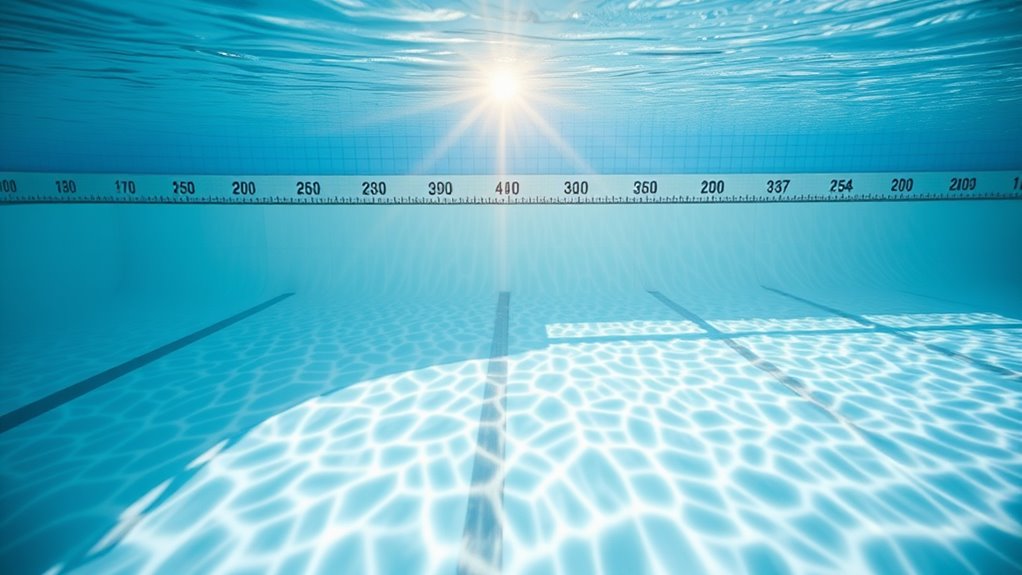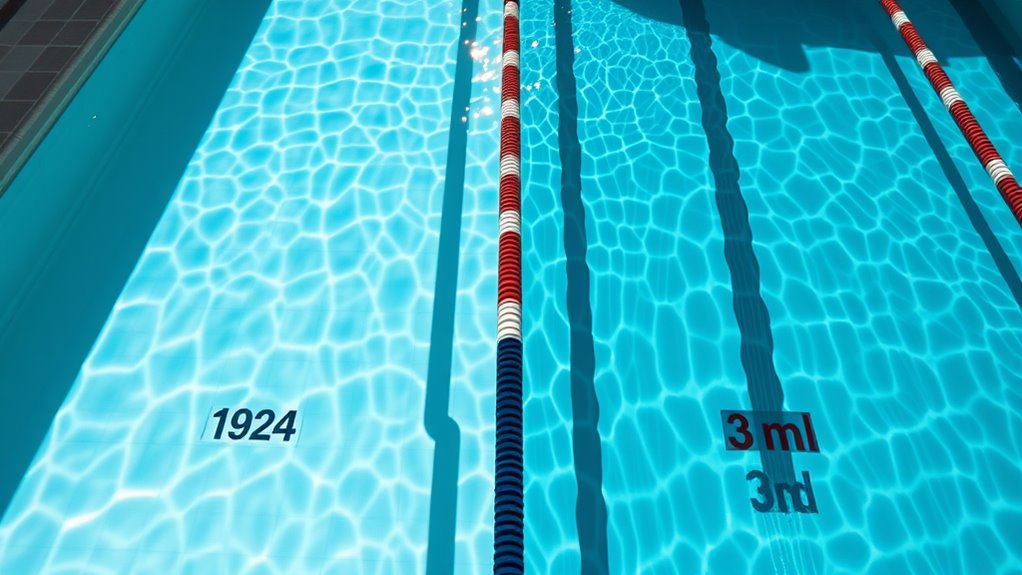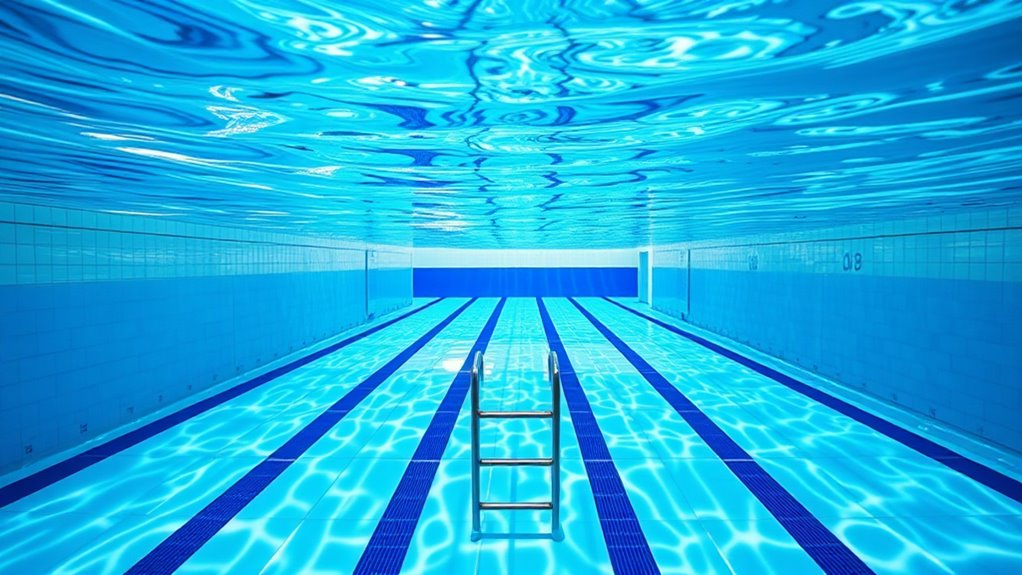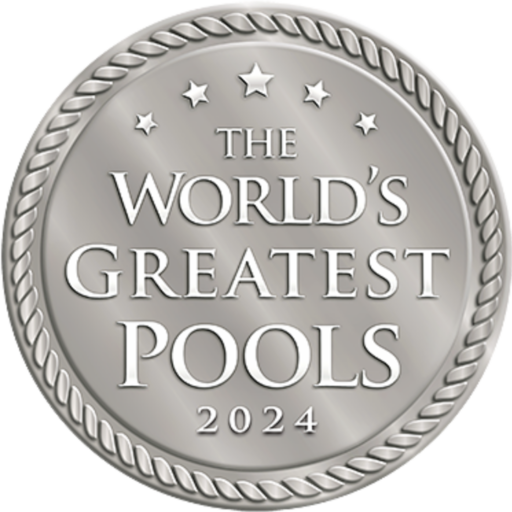Olympic swimming pools must maintain a minimum depth of 2 meters (6.6 feet) throughout the competition area, with a deeper 3-meter (9.8-foot) section required under the starting blocks. You'll find these strict depth requirements are designed to reduce water turbulence, improve performance, and guarantee athlete safety during dives and competitive events. Modern facilities often feature adjustable pool floors, and the specific engineering behind these depth standards reveals fascinating technical innovations.
The Standard Depth Requirements for Olympic Pools

Olympic swimming pools must maintain a minimum depth of 2 meters (6.6 feet) throughout the competition area, with 3 meters (9.8 feet) recommended for ideal performance. You'll find that pool construction standards for Olympic facilities strictly adhere to FINA (International Swimming Federation) regulations, which specify these depth requirements to guarantee athlete safety and best racing conditions.
The depth measurement must remain consistent across the main competition lanes, though it's permissible to have varying depths in different sections of the pool. You'll notice that modern Olympic pools often feature adjustable floors, allowing venue operators to modify depths for different events or public use. This technology has revolutionized pool construction, enabling facilities to enhance their utility while maintaining Olympic standards when required.
Why Pool Depth Matters in Competitive Swimming
Pool depth greatly influences competitive swimming performance through multiple hydrodynamic factors. When you're swimming in a deeper pool, you'll experience reduced turbulence and wave reflection from the bottom, which can provide a competitive advantage during races.
Deeper pools naturally reduce water resistance and wave reflection, giving competitive swimmers an edge in maintaining speed and efficiency.
- Water displacement creates less turbulent flow in deeper pools, minimizing resistance
- Reduced wave bounce-back from the pool floor improves swimming conditions
- Proper depth helps prevent dangerous surface breaks during diving
- Deep water allows for more effective underwater dolphin kicks
FINA's depth regulations guarantee fair competition across all venues while maintaining safety standards. The deeper water column enables you to execute technical movements without interference from bottom-generated currents. You'll notice the difference particularly during starts and turns, where ideal depth helps maintain momentum and reduces the impact of wave energy on your performance.
Historical Changes in Olympic Pool Depth Standards

Olympic swimming pool depth regulations have evolved considerably since the early days of competitive aquatics. You'll find that prior to 1972, there wasn't a strictly enforced minimum depth requirement for Olympic pools, though most facilities maintained at least 1.2 meters deep. The 1972 Munich Olympics established new standards that you'd recognize today, requiring a minimum depth of 2 meters for competitive pools to accommodate the increasingly technical aspects of starts and turns.
Early Depth Regulations
When competitive swimming initially emerged as an Olympic sport in 1896, regulations for pool depth weren't strictly standardized. The historical regulations for early competitions differed considerably between venues and host cities.
Key aspects of early Olympic pool depth standards included:
- Many pools were natural bodies of water with inconsistent depths
- Depths ranged from 3 to 20 feet depending on the location
- There wasn't a formal governing body to enforce uniform standards
- Local organizers often determined pool specifications independently
You'll find that it wasn't until the early 20th century that swimming federations began implementing more consistent depth requirements. This shift in the direction of standardization came as the sport evolved from informal competitions in diverse water bodies to purpose-built swimming facilities with specific technical specifications.
Modern Standards Since 1972
Since the 1972 Munich Olympics, international swimming federations have mandated strict minimum depth requirements of 2 meters (6.6 feet) for Olympic competition pools.
You'll find that modern Olympic pools must maintain this minimum depth throughout the racing course, though many facilities exceed these specifications. The depth measurements typically range from 2 to 3 meters (6.6 to 9.8 feet) across the pool's length, with some pools reaching depths of 3.5 meters (11.5 feet) in diving areas. These Olympic specifications guarantee ideal racing conditions by minimizing wave reflection from the pool bottom.
The standardization has also influenced the construction of training facilities worldwide, as you'll notice many competitive swimming venues now adhere to these depth requirements to provide athletes with consistent training environments that match Olympic conditions.
Impact of Pool Depth on Swimming Performance
The depth of a swimming pool directly influences an athlete's performance through complex hydrodynamic interactions. When you're swimming in an Olympic pool, you'll experience varying swimming dynamics based on the water depth beneath you. The buoyancy effects and wave patterns change considerably as you move through different depths.
Swimming pool depth creates complex dynamics that can make or break an athlete's performance through water resistance and buoyancy effects.
- Deeper pools reduce wave reflection from the bottom, minimizing turbulence that can slow you down
- Ideal depth allows you to maintain proper body position without feeling "pulled down" by bottom suction
- Shallower areas can create wave resistance that affects your speed and stroke efficiency
- Water pressure variations at different depths impact your body's hydrodynamic profile
You'll find that elite swimmers perform best in pools with consistent depth throughout the racing lanes, as this guarantees uniform water flow patterns during competition.
Design Features of Modern Olympic Swimming Facilities

Modern Olympic swimming facilities integrate advanced technical control systems that monitor water quality, temperature, and circulation in real-time. You'll find automated touchpads, precision timing equipment, and underwater cameras that meet FINA's strict competition standards. The pool's mechanical systems include sophisticated filtration units, UV sanitization, and chemical controllers that maintain ideal swimming conditions throughout major events.
Competition Pool Technical Standards
International Olympic swimming facilities must adhere to strict technical specifications established by FINA (Fédération Internationale de Natation). As one of the primary regulatory bodies in competitive swimming, FINA guarantees pool dimensions and technical standards meet exacting requirements for Olympic competition.
- Pool length must measure exactly 50.0 meters between touch panels
- Water temperature must be maintained between 25-28°C (77-82.4°F)
- Minimum pool width requirement is 25.0 meters for 10 lanes
- Lane ropes must have a diameter of 0.05 to 0.15 meters
You'll find these standards rigorously enforced in every Olympic venue. The specifications guarantee fair competition conditions and enable the potential for world records. FINA's technical requirements also address lighting, water quality, and starting block specifications.
Support Equipment and Controls
Supporting a world-class Olympic swimming facility requires sophisticated equipment and control systems that work seamlessly behind the scenes. You'll find advanced filtration systems, water chemistry controllers, and precision timing equipment monitoring every aspect of pool operations.
The support equipment includes automated chemical dosing systems, UV sterilization units, and high-capacity pumps that maintain ideal water conditions. You'll see digital control panels managing water temperature, chemical balance, and circulation rates. Competition-grade timing systems feature touch pads, electronic scoreboards, and underwater sensors that track swimmers' performances to 1/1000th of a second.
Modern facilities also integrate environmental controls for air temperature, humidity, and ventilation. These systems work together through centralized command centers, ensuring prime conditions for both athletes and spectators during Olympic events.
Safety Considerations and Pool Depth Regulations
Pool depth regulations for Olympic facilities stem from extensive safety research and real-world competitive data. You'll find strict safety protocols governing both minimum and maximum depth measurements to protect athletes while enabling peak performance.
Key safety regulations include:
- Minimum depth of 2 meters (6.6 feet) for the initial 6 meters of the pool
- Required depth of 3 meters (9.8 feet) where starting blocks are installed
- Consistent 2-meter minimum depth throughout racing lanes
- Maximum depth variation of 2.5 centimeters across racing lanes
These specifications guarantee safe diving entry, prevent turbulence issues, and minimize injury risks during competitive events. You must understand that pool depth directly impacts diving angles, underwater movements, and turn mechanics – making precise depth control essential for both safety and competitive integrity.
Regional Variations in Olympic Training Pool Depths
While Olympic competition pools maintain standardized depths, training facilities across different regions show notable depth variations based on local factors and national team preferences.
You'll find that regional training facilities in Europe often feature pools with varying depths, typically ranging from 2 to 3 meters, which accommodate both competitive swimming and diving programs. In contrast, many Asian facilities have implemented pool adaptations with slightly shallower depths of 1.8 to 2.5 meters, optimizing their spaces for swimming-specific training. North American facilities frequently utilize pools with uniform depths of 2 meters, though some newer installations include movable floors for depth adjustments. Australian training centers often incorporate deeper sections at one end, reaching up to 3.5 meters, to facilitate dive training and resistance work.
Technical Aspects of Maintaining Proper Pool Depth
Maintaining precise Olympic pool depths requires sophisticated monitoring systems and regular calibration procedures. You'll need to understand the complex interplay between water circulation and structural integrity to guarantee consistent depth measurement across the entire pool surface.
Precise depth control in Olympic pools demands advanced monitoring technology and a deep understanding of water dynamics and structural systems.
Key technical requirements for Olympic pool depth maintenance:
- Automated depth sensors with real-time monitoring capabilities accurate to within 2mm
- Advanced water circulation systems that prevent uneven pool floor settling
- Pressure-based measurement devices installed at strategic points throughout the pool basin
- Computer-controlled water level management systems with automatic compensation features
When you're operating an Olympic facility, you must conduct daily depth measurements and maintain detailed logs of any variations. The pool's hydrostatic pressure system helps prevent structural shifting that could affect depth uniformity, while modern depth monitoring technology guarantees compliance with international competition standards.
Future Trends in Olympic Pool Design and Depth Standards
As competitive swimming evolves into the future, Olympic pool design standards continue to adapt to emerging technologies and athlete performance requirements. You'll notice a growing emphasis on groundbreaking materials that reduce turbulence and improve speed, while maintaining strict depth requirements for athlete safety.
Watch for upcoming changes in pool design that incorporate eco-friendly designs, including energy-efficient filtration systems and sustainable water management solutions. These developments won't compromise the established depth standards but will focus on reducing environmental impact. You'll also see advanced sensor systems being integrated into pool walls and floors to provide real-time data on water conditions and athlete performance metrics. The future of Olympic pools lies in striking the perfect balance between maintaining traditional depth requirements and embracing sustainable, performance-boosting technologies.
Frequently Asked Questions
How Much Does It Cost to Build an Olympic-Sized Swimming Pool?
You'll need to invest between $300,000 to $2 million to build an Olympic-sized swimming pool, with construction materials being a major cost factor. The price varies markedly based on location, materials chosen, and local regulations. Don't forget to account for maintenance costs, which can run $40,000 to $100,000 annually, including chemicals, heating, staffing, and equipment repairs. Your final cost depends on whether it's indoor or outdoor.
Can Regular Swimmers Practice in Olympic Swimming Pools?
Yes, you can practice in Olympic swimming pools, but pool access varies by location and facility policies. Many competitive swimming centers and sports complexes with Olympic-sized pools offer public sessions and membership options. You'll experience significant training benefits, including improved endurance from the longer 50-meter length and better pacing development. The wider lanes and superior water circulation systems also provide ideal conditions for your swimming practice.
Which Olympic Venue Has the Deepest Swimming Pool?
You'll find the deepest venue for Olympic swimming at the Tokyo Aquatics Centre, built for the 2020 Olympics. Its competition pool features a unique movable floor system that can adjust depths up to 3 meters, though it's typically set at 2 meters for races. While many Olympic pools share similar depths, this venue's adjustable floor technology makes it stand out, allowing for multiple aquatic disciplines and ideal training conditions.
How Often Is the Water Replaced in Olympic Pools?
You'll find that Olympic pools don't typically replace their entire water volume regularly. Instead, they maintain strict pool hygiene through continuous filtration and treatment systems. You'll see about 1-2% of the water replaced daily due to evaporation, splash-out, and backwashing. Water maintenance protocols include constant monitoring of chemical levels, pH balance, and water quality. The system continuously filters the pool's entire volume every 4-6 hours.
What Temperature Is Maintained in Olympic Swimming Pools?
You'll find that Olympic swimming pools maintain a strict temperature range between 25-28°C (77-82.4°F), with 26°C (78.8°F) being the ideal target. This temperature helps optimize both athlete performance and water quality. FINA regulations require precise monitoring to guarantee consistent pool temperature throughout competitions. You'll notice it's cooler than recreational pools, as this range helps prevent athlete fatigue while supporting peak performance during intense competition.



